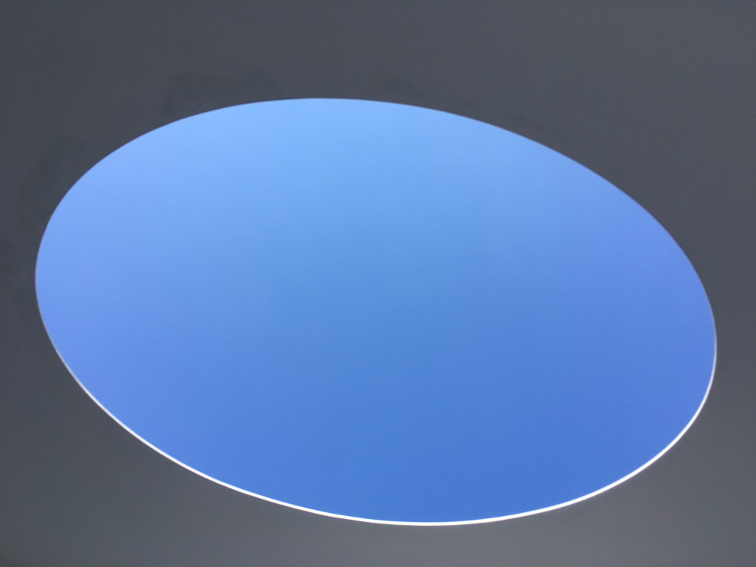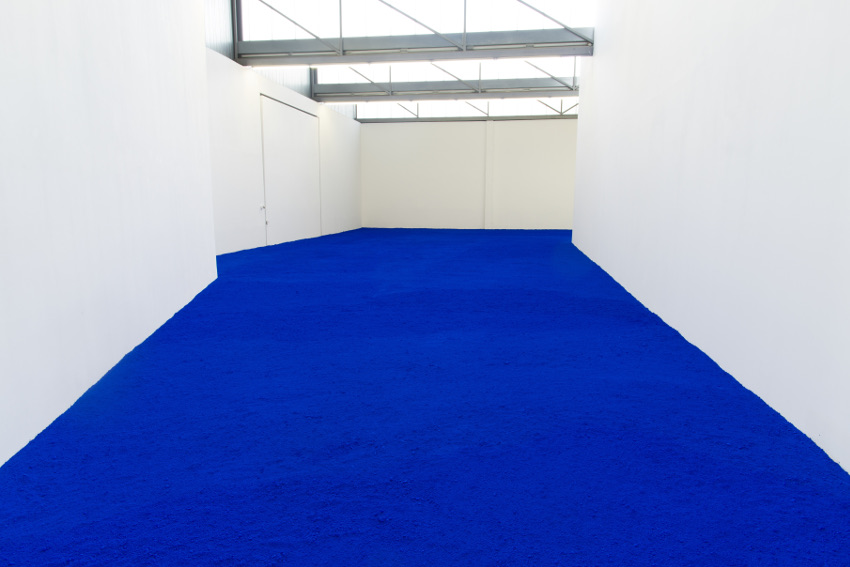Visiting The Bernar Venet Foundation
Aug 19, 2018
French conceptual artist Bernar Venet wants you to celebrate the legacy of Yves Klein, but he also wants you to work for it. Klein would have turned 90 this year. In his memory, the gallery of the Bernar Venet Foundation created the largest ever manifestation of “Pigment Pur,” a landmark installation Klein first exhibited in 1957. But this is where the work comes in. If you want to see this installation, you first have to make a reservation with the gallery, and then you have to find it. On its website, all you will see is a mailing address for the Foundation offices in New York City. The actual gallery is in Le Muy, in the south of France, tucked in a residential village about an hour west of Cannes by car. There are no signs directing you to the location, and you may not even be able to find anyone in the village willing to give you directions. But if you simply drive north from the center of town along the Route de Callas, you will soon see outcroppings of steel forms peeking above the hedges along the side of the road. That is your destination. The place is magical. It is divided by a river. On one side you will find the factory where some large-scale sculptures are exhibited, as well as the gallery which is currently hosting the Yves Klein exhibition, and a mill. On the other side of the river you will find the sculpture park. The mill is not open to visitors, because this happens to be where Bernar Venet actually lives, which is the reason he does not go out of his way to make it easy to find. But make no mistake, this is a public destination—part museum and part abstract art wonderland where works by several of the most influential artists of the past century wait to be discovered.
The Venet Klein Connection
Bernar Venet built his foundation as a place to display his own artworks, which range from small installations to paintings to massive metal sculptures. It was the massive sculptures that inspired him to buy this property and transform it into a showplace. The property ounce housed a mill, and had large buildings with reinforced floors. Since his large metal sculptures are too large and too heavy for most galleries and museums in the world to exhibit, Venet specially constructed the premises at the Foundation to accommodate their extreme presence. The property is also a place for Venet to show his own personal art collection, and to host temporary and long term exhibitions of the work of other artists. Interspersed all around the property are sculptures by luminaries such as Sol LeWitt, Richard Long, Carl Andre, Ulrich Rückriem, and Larry Bell. In addition, you will find permanent installations by James Turrell, Frank Stella, and François Morellet.

James Turrell - Elliptic, Ecliptic Skyspace
The connection between Venet and Yves Klein goes back to when Venet was just leaving the army and embarking on the early stages of his art career. He was inspired by Klein and the other Nouveau Realists, not so much by the physical qualities (or lack thereof) of their works, but by their intellectual attitude towards new possibilities in conceptual art. Ultimately, in fact, Venet took a unique path in his art career, which in many ways represents the antithesis of the career of Klein. Unlike the ephemeral artworks for which Klein was known, Venet dedicated himself to making monumental works made out of metal—objects that come as close to defying ephemerality as possible. The forms Venet makes also, however, display a sense of grace—a visual softness to accompany the material hardness. They are in a strange way geometric and mathematical while also seeming biomorphic or organic.

Venet Foundation - Effondrement 16 arcs - Bernar Venet 2018. © Jerome Cavaliere Marseille. Courtesy Archives Bernar Venet New York
Pure Pigment
The idea behind recreating “Pigment Pur” (which just means pure pigment) goes back to the first time Klein exhibited this unique work. Klein had recently invented International Klein Blue (IKB), a type of blue paint that stayed vibrant even after being applied to a surface. Klein came to realize that even as vibrant as it was, even this wonderful paint still never truly matched the “blueness” of the raw blue pigment itself. “Pigment Pur” was a spot of floor on which Klein poured the raw, dry pigment. When he first installed the work, Klein wrote in his personal notes, “Pure pigment, exhibited on the ground, became painting itself rather than a hung picture. It did not alter the pigment grains, as inevitably does oil, glue, or even my own special fixative.” But then Klein also lamented that in order to look at this piece the viewers had to stand upright and look down at the work, rather than comfortably gazing straight ahead at the wall.

Yves Klein - exhibition view
Bernar Venet has addressed that concern with his ingenious recreation of “Pigment Pur.” The work is installed in a long room with a rising floor, which disappears into a horizon point. Viewers can stand in a relaxed way and gaze ahead, looking outward into a beautiful abyss of pure, raw, blue pigment, made all the more brilliant by the stark white walls. This is not the first time “Pigment Pur” has been recreated. Most infamously, a small, rectangular version of the work was installed in 2017 at the Bozar Museum in Brussels, and was subsequently walked on by a viewer, who not only marred the pristine surface of the work but then tracked the blue pigment across the floor. No doubt Klein would have been amused by this act, and even perhaps would have found it an improvement. But he also surely would have been most pleased by this monumental celebration of his idea at the Venet Foundation. It demonstrates that even here, amidst some of the heaviest, most enduring works of art on the planet, there is room for something ethereal—a reminder of the harmony encapsulated by this magical place.
Featured image: Gallery - Yves Klein Exhibition view
By Phillip Barcio



